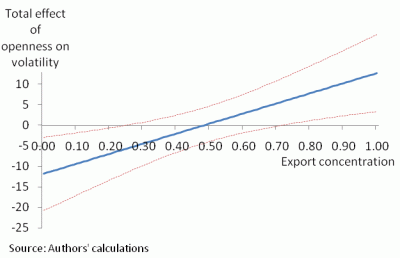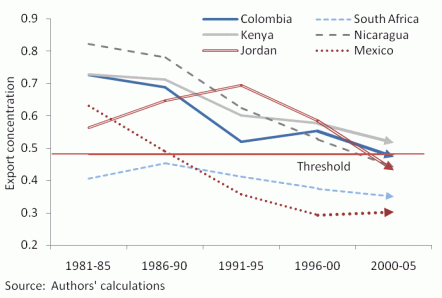The epicentre of the global economic crisis was the financial markets of the industrialised world, yet developing countries have felt the tremors. Many, including those without close financial ties to the developed world, were driven into recession as global demand plummeted and the largest drop in global trade volumes since the Second World War ensued. Naturally, open economies heavily reliant on export revenues were among those hardest hit by the crisis. This notion has led to a renewed interest in the relative merits of export-led growth strategies for developing countries (Harrison and Rodriguez-Clare 2009).
What does an increase in trade openness mean for vulnerability to global shocks?
It is widely believed that trade openness is, under suitable conditions, positively associated with growth outcomes. But does this come at the cost of a more volatile growth path due to a greater vulnerability to global shocks? After all, it is not unreasonable to expect that an open economy will face a larger number of adverse shocks. On the other hand, it is clear that the possibility of international risk sharing is greater in an open economy through both explicit and implicit insurance. These include joint ventures, international lending, production diversification, and formal insurance contracts. Moreover, the disciplining nature of international competition and the prevalence of formal international contracts could potentially limit the risk of domestic policy mistakes. Therefore, while it is unclear, ex ante, whether the effect of openness on growth volatility should be positive or negative, it can be argued that the composition of the export basket matters in the determination of its sign.
In particular, the vulnerability of countries to (some types of) external shocks should be reduced when these countries are better diversified in their exports. More specifically, the effect of trade openness on growth volatility – whether negative or positive on average – is likely to be exacerbated when the country in question exports either a relatively small set of products, or sells its goods to a small number of destination markets. The argument is that a higher degree of concentration in exports would imply that any idiosyncratic price shock experienced is more likely to have a substantial impact on the country's terms of trade, and this would then induce greater fluctuations in a country's growth process. Furthermore, a higher degree of diversification would likely imply that a country is involved in a larger number of both implicit and explicit international insurance schemes, which would similarly serve as a cushion against such fluctuations.
The average effect of openness on volatility is indeterminate, but a majority of diversified economies benefit
While the relationship between openness and growth has been investigated thoroughly, the link between openness and growth volatility is less well understood. Various studies have argued that trade openness increases macroeconomic volatility (see for example Easterly et al. 2001), yet there is no clear consensus in the literature to date. In a recent contribution using industry-level data, di Giovanni & Levchenko (2009) investigate the channels through which trade openness might affect volatility. They find that trade openness appears to lead to countries becoming more specialised in their exports. This is problematic given that openness is likely to also expose a country to a greater number of shocks.
In a recent empirical analysis (Haddad et al. 2010), we show that whether openness has a positive or negative effect on volatility does indeed depend on how diversified a country’s export basket is. We study a cross-section of 77 developing and developed economies between 1976 and 2005. Figure 1 shows how the level of export diversification determines the total effect of openness on growth volatility. The plot is based on the share of the 5 most important products in total exports as a diversification measure. We can see that the impact of trade openness on volatility is significantly lower than zero, with 90% confidence, as long as a country scores lower than about 0.24 on the diversification variable. The effect gradually increases and changes sign (threshold) at about 0.48. In contrast, above a value of about 0.71, the impact of trade openness on growth volatility is significantly positive. Equivalent illustrations can be made using other product diversification indicators (Haddad, Lim & Saborowski, 2010). When using indicators of geographic diversification, on the other hand, the results are not as telling.
Figure 1. Total effect of trade openness on growth volatility
Let us put the threshold value of 0.48 into context. Based on Figure 1, it is straightforward to determine the share of countries in the sample whose value on the 5 product indicator lies below the threshold and the share of those whose value lies above it. Performing this exercise for a variety of indicators of export diversification across products, we consistently find that the threshold value is located in the upper part of the respective indicator’s distribution. In other words, a majority of countries benefit from increased openness by way of reduced volatility.
The threshold level of diversification can also be understood relative to levels of income per capita (Figure 2). As expected, all high income economies, with the exception of Norway and Ireland, have attained levels of diversification that lie substantially below the threshold value we identified, implying that they are likely to enjoy the benefits of trade openness while being well shielded against global shocks via the participation in a large number of global value chains. Yet, we also see that the vast majority of countries above the diversification threshold are low income countries, although a large number of low income economies also fall below the threshold. Whereas countries such as Nigeria and Botswana are troubled by extremely high export concentration, China and Nicaragua have reached levels of diversification that fall clearly below the threshold.
Figure 2. Distribution of countries by income per capita
Can developing countries diversify quickly enough?
The question then arises. Can developing countries that choose to pursue a diversification path do so expediently, so that they quickly fall below the diversification threshold?
The answer is yes, and this is clearly illustrated in Figure 3, which follows the path of six developing countries toward lower levels of diversification over the sample period, using the 5 product measure. Countries such as Nicaragua, Kenya, or Colombia had very concentrated export baskets at the beginning of our sample period, yet successfully diversified to levels close to or below the threshold value we have identified. This illustrates that diversification - as a means of deriving larger benefits from trade openness and at the same time shielding the economy against global shocks - is indeed a feasible and realistic policy goal.
Figure 3. Diversification trends
What role for policy?
These results carry significant policy relevance, especially in the context of the current economic crisis. One of the chief arguments voiced against export-led growth strategies for developing countries is that economically-open countries are more prone to external shocks. But are they necessarily more strongly affected by external shocks by way of higher volatility? Given that more open economies are likely to be involved in a wider range of insurance schemes, along with the disciplinary effect of increased international competition, the total effect of openness on volatility could also go the other way. While agnostic as regards the sign of the average effect of openness on volatility, these results suggest that it is likely to be negative for countries with a sufficiently diversified export basket. Moreover, a majority of the countries in the sample appear to fulfil this condition. These results thus amount to a powerful argument in favour of open borders, when accompanied by a policy of export differentiation. The complementarity of the policies is especially important, since there is some evidence that trade openness alone may, paradoxically, lead to export concentration (di Giovanni & Levchenko 2009).
These complementary policies should be foremost on the minds of developing-country policymakers contemplating the way forward in the aftermath of the crisis. More specifically, policymakers can encourage entrepreneurial export activity by instituting a broad- based system of tax relief and subsidies that support the discovery process, complemented by a liberal trading regime that combines export incentives while relaxing restrictions on the import of intermediates. One way to do this is to facilitate the costly search process for exporters by alleviating information externalities (export promotion agencies) or setting tax incentives for firms to engage in the costly trial and error process of exporting. Not only should export incentive schemes aim at promoting exports of new products, policymakers should also encourage production diversification as such. This would entail setting incentives supporting the discovery of profitable choices of products, perhaps via tax incentives, subsidised public R&D, or laws and regulations that provide greater access to high risk insurance.
References
Easterly, William R, Roumeen Islam, and Joseph Stiglitz (2001), “Shaken and Stirred: Explaining Growth Volatility”, in Annual World Bank Conference on Development Economics, ed. by Boris Pleskovic and Nicholas Stern (Washington:World Bank).
Haddad, Mona, Jamus J. Lim & Christian Saborowski (2009). "Trade Openness Reduces Growth Volatility When Countries are Well Diversified". World Bank Policy Research Working Paper 5222.
Harrison, Ann E. & Andres Rodriguez-Clare (2009). "Trade, Foreign Investment, and Industrial Policy for Developing Countries". NBER Working Paper 15261.
Di Giovanni, Julian & Andrei A. Levchenko (2009). "Trade Openness and Volatility". Review of Economics and Statistics 91(3) (August): 558-585.






